One of the most deeply rooted festivals in folk and Christian religious life is the “Adoration of the Three Kings other Three Wise Men”. In this event they come together many elements of different religious and cultural backgrounds. We can recall the religious ferment of the Roman Empire, precisely time when Jesus was born, flattering all syncretism. Christian religion have incorporated many elements of Eastern religions of Chaldea, Mesopotamia, Persia, Asia Minor, Egypt, Judea and especially of Greco-Roman and philosophical thought. In all these syncretic religions astral component, highly developed among the Chaldeans in Mesopotamia, is very important.
I'll try to dig a little deeper on the holiday and iconography of the "Adoration of the Magi", one of the most commonly used scenes by Christianity from the first centuries.
The Feast of Kings is one of the epiphanies (from Greek επιφάνεια, epifaneia, "manifestation", composed of ἐπί-, epi, on, over, and φαινεῖν , verb fainein, appear, show), or manifestation of God to men. The other epiphanies are the baptism of Jesus in the Jordan River and the miracle of the wedding at Cana.
The essential basis text is the reference made in the Gospel of Matthew, only the four canonical Gospels (because it is part of the norm or Christian "canon"); three of them, Matthew, Mark, Luke, are also called synoptic (from Greek συν, syn, with, together, and οψις, opsis, view,; ie, we can do a parallel view of them) because they present many coincidences but also significant differences, as this worship of the magi.
This Gospel of Matthew is preserved in Greek and often it is dated as no earlier than 80, ie 50 or 60 years after the death of Christ. There is a hypothesis that considers the existence of a first version in Aramaic, based on a quote from Eusebius of Caesarea (who lived between approximately 265 and 339), referred to Papias of Hierapolis (who lived between 69 and 150).
The text of St. Matthew 2: 1-12 says:
Now when Jesus was born in Bethlehem of Judea in the days of Herod the king, behold, there came wise men from the East to Jerusalem, saying, “Where is He that is born King of the Jews? For we have seen His star in the East and have come to worship Him.” When Herod the king had heard these things, he was troubled, and all Jerusalem with him. And when he had gathered all the chief priests and scribes of the people together, he demanded of them where Christ should be born. And they said unto him, “In Bethlehem of Judea, for thus it is written by the prophet:
‘And thou, Bethlehem, in the land of Judah, art not the least among the princes of Judah; for out of thee shall come a Governor, that shall rule My people Israel.’”
Then Herod, when he had privily called the wise men, inquired of them diligently what time the star appeared. And he sent them to Bethlehem and said, “Go and search diligently for the young child, and when ye have found him, bring me word again, that I may come and worship him also.” When they had heard the king, they departed; and lo, the star which they saw in the East went before them until it came and stood over where the young Child was. When they saw the star, they rejoiced with exceeding great joy. And when they had come into the house, they saw the young Child with Mary His mother, and fell down and worshiped Him. And when they had opened their treasures, they presented unto Him gifts: gold and frankincense and myrrh. And being warned by God in a dream that they should not return to Herod, they departed into their own country another way.
(21st Century King James Version)
The Latin text reads:
Cum autem natus esset Iesus in Bethlehem Iudaeae in diebus Herodis regis, ecce Magi ab oriente venerunt Hierosolymam dicentes: “ Ubi est, qui natus est, rex Iudaeorum? Vidimus enim stellam eius in oriente et venimus adorare eum ”. Audiens autem Herodes rex turbatus est et omnis Hierosolyma cum illo; et congregans omnes principes sacerdotum et scribas populi, sciscitabatur ab eis ubi Christus nasceretur. At illi dixerunt ei: “ In Bethlehem Iudaeae. Sic enim scriptum est per prophetam:
"Et tu, Bethlehem terra Iudae,
nequaquam minima es in principibus Iudae;
ex te enim exiet dux,
qui reget populum meum Israel" ”.
Tunc Herodes, clam vocatis Magis, diligenter didicit ab eis tempus stellae, quae apparuit eis; et mittens illos in Bethlehem dixit: “ Ite et interrogate diligenter de puero; et cum inveneritis, renuntiate mihi, ut et ego veniens adorem eum ”. Qui cum audissent regem, abierunt. Et ecce stella, quam viderant in oriente, antecedebat eos, usque dum veniens staret supra, ubi erat puer. Videntes autem stellam gavisi sunt gaudio magno valde. Et intrantes domum viderunt puerum cum Maria matre eius, et procidentes adoraverunt eum; et apertis thesauris suis, obtulerunt ei munera, aurum et tus et myrrham. Et responso accepto in somnis, ne redirent ad Herodem, per aliam viam reversi sunt in regionem suam.
It should be noted that the text speaks simply of "wise men from the East" and not of "three kings" magi, numerical and nominal accuracy subsequently added.
Second it is a star announcing the birth. As it is known, it has been widely theorized about the characteristics of this star: a comet ?, a supernova ?, a conjunction of several stars? It does a meteor ?.
Already Origen (186- 185 or 254 or 255), exegete (from Greek ἐξηγητή, exegete, interpreter, and this from ἐξηγεομαι, exegueomai, 'explain', interpret) thought it was a comet.
In the eastern society and by its influence in Greco-Roman, stars and atmospheric and celestial phenomena are signs of the gods. Of course, in the ancient world comets were unmistakable signs of a major event; Mithridates births and Augustus were also preceded by the appearance of a comet.
Justino Frontino, historiador romano del siglo II, nos informa a propósito del rey Mitrídates en sus Historias Filípicas, Historiarum Philippicarum, XXXVII, 2:
Justin Frontinus, the Roman historian of the second century, tells us about the King Mithridates in his Historiarum Philippicarum, XXXVII, 2:
The future greatness of this prince even signs from heaven had foretold; for in the year in which he was born, as well as in that in which he began to reign, a comet blazed forth with such splendour, for seventy successive days on each occasion, that the whole sky seemed to be on fire. It covered a fourth part of the firmament4 with its train, and obscured the light of the sun with its effulgence; and in rising and setting it took up the space of four hours. (Translated by John Selby Watson (London: Henry G. Bohn, 1853)
II. Huius futuram magnitudinem etiam caelestia ostenta praedixerant. 2 Nam et eo quo genitus est anno et eo quo regnare primum coepit stella cometes per utrumque tempus LXX diebus ita luxit, ut caelum omne conflagrare videretur. 3 Nam et magnitudine sui quartam partem caeli occupaverat et fulgore sui solis nitorem vicerat; et cum oreretur occumberetque, IV horarum spatium consumebat.
Virgil in his Aeneid, 10, 272 makes a reference to comets:
it seemed as when in cloudless night a comet's blood-red beam
makes mournful splendor, or the Dog-star glows,
which rises to bring drought and pestilence
to hapless men, and with ill-omened ray saddens the sky.
(Translated by Theodore C. Williams. Boston. Houghton Mifflin Co. 1910).
non secus ac liquida siquando nocte cometae
sanguinei lugubre rubent aut Sirius ardor,
ille sitim morbosque ferens mortalibus aegris,
nascitur et laevo contristat lumine caelum.
Well, the grammarian Servius, commenting on the passage, tells us in his comments to the Aeneid X, 272
If this looks to the East, it means happy things for that party; if at noon, cheers for Africa and Egypt; if it looks to the West, the land of Italy will get its favor. It is said that it (the comet) appeared at the time that Augustus got the command; then they were announced to all peoples future joys.
qui si orientem attenderit, laetas res ipsi parti significat; si meridiem, Africae aut Aegypto gaudia; si occidentem inspexerit, terra Italia voti sui compos erit. hic dicitur apparuisse eo tempore quo est Augustus sortitus imperium; tunc denique gaudia omnibus gentibus futura sunt nuntiata.
In this context it is easy to understand the text of Origen (184/185 – 253/254) in which he ensures that the star of Bethlehem was a comet and its appearance is quite logical:
Orígen, Contra Celsum 1, 58-59:
58…We think that the star which appeared in the east was a new star and not like any of the oridinary ones, neither of those in the fixed sphere nor of those in the lower spheres, but it is to be classed with the comets which occasionally occur, or meteors, or bearded or har-shaped stars,or any other such name by which the Greeks may like to describe their different forms. We establish this point as follows.
59 It has been observed that at great events and the most far-reaching changes of history stars of this kind appear which are significant of changes of dynasties, or wars, or whatever may happen among men which has the effect of shaking earthly affairs. We have read in the book on comets by Chaeremon the Stoic how comets have sometimes appeared even when good evens were about to happen, and he gives an account of these. If the a comet, as it is called, or some similar star appears at new dynasties or other great events on earth, why is it amazing that a star should have appeared at the birth of a man who was to introduce new ideas among the human race and to bring a doctrine not only to Jews but also to Greeks and to many barbarian nations as well? (Translated by Professor Chadwick. Cambridge University Press)
Interestingly these beliefs in comets as heralds of positive and negative events are held until today and they are renewed each time the proximity of these stars is announced.
Many years later, the astronomer Johannes Kepler (1571-1630), related the star of Matthew with the conjunction in 7 BC of Jupiter and Saturn.
From then to now they have not stopped appear hypotheses that attempt to explain the appearance in the sky of this special light on whose account I do not go because they do high prestige astronomers.
In relation to this episode of the Adoration of the Magi it is also necessary at first to define who are the magicians.
As in another article in this blog I mentioned, the magicians term, magus, magician, μάγοι is not from Greek but Iranian origin. In Greek it has the double meaning of charlatans who dupe with his "magic" but also and especially the priests with a peculiar feature. The primitive religious Persian beliefs and other of Zoroastrianism conceive the world full of daemons and spirits. The souls of the dead, separated from the body, ascend to heaven, or better, to the heavens, because they are many. In this journey of ascent ritual action and sacrifices of the "magi" is very important. These priests are also experts and scholars of the sky and the astral relations, and therefore astronomers, astrologers (they are similar terms in the ancient world) and mathematicians, whom the Fathers of the Church always regarded as honorable people.
See: http://www.antiquitatem.com/en/wise-men-tiridates-nero-wizard-epiphany
The term also had, as I said, the negative connotation of phony and charlatan dealing with demons. Remember what was said in "Acts 3: 9," in which a phony, nicknamed Simon Magus, is repudiated, whom the apostle Peter, whose power came from the Holy Spirit confronts.
Even Jesus was himself an extraordinary magician and his power was able to beat the magic of demons, without using spells or incantations, but acting on their own behalf. So in early Christian art Jesus is depicted as thaumaturge (from Greek θαυματουργός thaumaturgous, skillful, clever, from θαῦμα, thauma, wonderful thing, and ἔργον, ergon, work), or person performing miracles, with a stick and the gesture of his hand as magicians do.
From this point of view, the magicians of Matthew would be true magicians who bowed their heads down and gave his power to the superior power of Jesus. It is evident that the Evangelist intended to show how magicians, then converted into kings of this world, render worship the Son of God, in a world where magic and knowledge of the stars have an important presence.
On the "social" echo of "wise Men" episode it gives us an idea the visit of Tiridates, King of Armenia, and magician also, to the emperor Nero. This tour was mentioned by me in the article referenced in above hyperlink. Some people have thought that it was this visit which was the model for the visit of the "magicians" to the child of Bethlehem.
An essential element is that the gift of the magi is three valuable products in the ancient world: gold, always expensive, incense similar to the value of gold used as perfume and ritual element, and myrrh, whose value was much higher than the other two, used in embalming the bodies of the dead. In Zoroastrianism also it is offered gold, frankincense and myrrh to Ahura Mazda. We'll see how they are several elements that relate the episode with Zoroastrianism and Mithraism.
On the relationship between "Mithraism" and "Christianity" I have published a recent article. See: http://www.antiquitatem.com/en/mithraisme-christianity-winter-solstice. I comment how the cult of Mithras is done in caves or underground temples or simulating a cave. Well, in the West is often locate the birth of Jesus in a manger portal but in the East the place is a cave, probably under the influence of the Mithraic cave.
Similarly, the episode of the Adoration of the Shepherds is probably a reflection of a similar act of the Shepherds with Mitra.
However, where the influence is evident, ie, it is seen with the eyes, is in the iconography of the Magi. First it should be specified that there do not were always three; they are represented sometimes two, six, eight and up to twelve, as in the Syriac and Armenian rites. That is, the number three has no support in Scripture.
In the catacombs of St. Priscilla the oldest painting is preserved and in them are three. The frescoes of this Catumba ranging from mid-second century to the mid-third century.
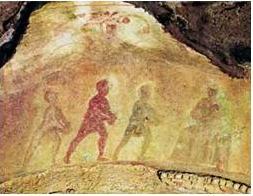
In the catacomb of Peter and Marcellinus they are represented two and they are of fourth century.
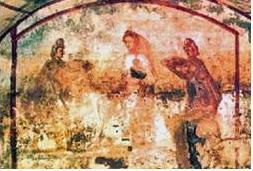
In the third century theologian Origen (185-253) indicated that the Magi were three, since there are three gifts that are named in the Gospel of Matthew: gold, frankincense and myrrh, a figure that then Pope St. Leo the Great (Leo I the Great) reaffirms and imposed until today, probably for coincide with the three gifts and probably to symbolize the three then known continents: Europe, Asia and Africa, as expressly the Pseudo Bede (ca. 672-27 May 735) stated in the Middle ages in his In Evangelium Matthaei, chap. II, also relating them to the three sons of Noah:
Mystically the three Magi (Wise Men) symbolize the three parts of the world, Asia, Africa and Europe or the human race, which took its origin in the three sons of Noah.
Mystice autem tres Magi, tres partes mundi significant,Asiam, Africam, Europam, sive humanum genus, quod a tribus filiis Noe seminarium sumpsit
Como decía, el papa San León Magno (circa 390 – 461) ratificó la cifra de tres, que es la que con más frecuencia se repite en las representaciones. Dice en su Tratado o Sermón 31, en la Festividad de la Epifanía 1:
As I said, Pope St. Leo the Great (circa 390-461) confirmed the figure of three, which is the most frequently repeated in the representations. He says in his Sermon 31, on the Feast of the Epiphany 1:
Sermon XXXI.
On the Feast of the Epiphany, I.
To three wise men, therefore, appeared a star of new splendour in the region of the East, which, being brighter and fairer than the other stars, might easily attract the eyes and minds of those that looked on it, so that at once that might be observed not to be meaningless, which had so unusual an appearance. He therefore who gave the sign, gave to the beholders understanding of it, and caused inquiry to be made about that, of which He had thus caused.
Sancti Leonis Magni Tractatus XXXI
Tribus igitur magis in regione orientis stella nouae claritatis apparuit, quae inlustrior ceteris pulchriorque sideribus, facile in se intuentium oculos animosque conuerteret, ut confestim aduerteretur non esse otiosum, quod tam insolitum uidebatur.
Dedit ergo aspicientibus intellectum, qui praestitit signum, et quod fecit intellegi, fecit inquiri, et se inueniendum obtulit requisitus.
I reproduce two of the oldest representations of the scene, one of Syracuse in Sicily:

Sarcophagus of Adelfa. Siracusa. IV century
And another rough of Boville Ernica in Italy, also of the fourth century and which is postulated to be the oldest.

The manger under cover of Early Christian sarcophagus of Boville Ernica (Italy) of the fourth century.
Well, the three wise men are represented from the beginning dressed in Persian costume which is also with always Mitra is represented: short tunic, pants called anaxyrides and the Phrygian cap or pileus (object which I will comment at another time: remember that it is a symbol of freedom that was adopted, for example, by the French revolutionaries and later by many others, including entire countries).

Mithraeum "Barberini, Rome, mural painting. III century
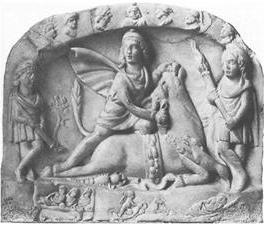
In Roman iconography of the East, for example the pedestal of the obelisk of Theodosius in Constantinople, in the late fourth century, in which the barbarians pay tribute to the emperor with his sons Arcadius and Honorius and his wife Gala, the Persians are depicted with this suit and the Thracians with skins.
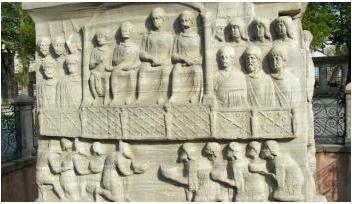
This Persian dress of the three Wise Men is displayed in all its definition in the Sarcophagus of Isacio – San Vitale, Ravenna, IV or V century, in which the Virgin Mary has become the living throne of the Child Jesus. The three Magi seem to repeat the same figure, which some experts interpreted as a reflection of some magical formulas in which the elements are repeated three times.
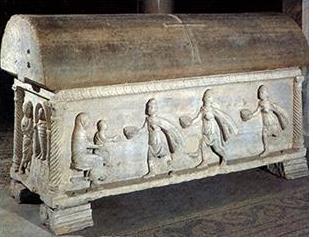
A similar scene, but rougher, is the sarcophagus of Aurelius, of the catacomb of San Lorenzo Fuori le Mura – Rome, of the fourth century, now in the Vatican Museum.
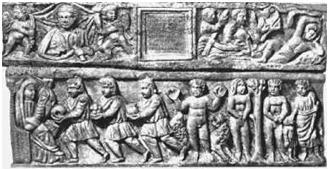
Mechanical and perhaps magical repetition of the three kings absolutely equal is seen best in another example
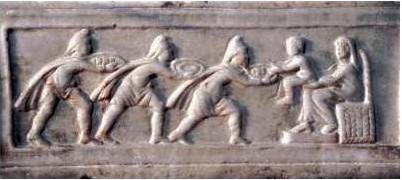
This dress was maintained for a long time, as evidenced by the various existing representations in the Middle Ages, which is evidence of the persistence of rites and myths.
There is a tradition or legend referring to the invasion and conquest of Palestine by the Persian Sassanid king Khosrau II in 614. Their general Shahrbaraz, impressed by the dress of the Wise Men in the mosaics which that adorn it, ordered not to destroy the famous basilica of the Nativity in Bethlehem and that the building be spared; he interpreted that the figure represented his fellow countrymen, wearing Persian clothing.
It is no longer as a legend, but it expresses the widespread awareness that the Magi came from the East, Persia. What is unacceptable is that in hundreds of internet references, including some books that claim to seriousness endorsed by any college, this anecdote is referred to the Byzantine churches of Ravenna, in Italy, which I will quote below. How to explain a supposed invasion of Italy by the Sassanid Persians in 614?
The conversion of the Magi into kings, or better, the syncretism again of wizards and kings, was undoubtedly due to the desire to realize the verses of Psalm 72: 9-11:
Vor ihm werden sich neigen die in der Wüste, und seine Feinde werden Staub lecken.
Die Könige zu Tharsis und auf den Inseln werden Geschenke bringen; die Könige aus Reicharabien und Seba werden Gaben zuführen.
Alle Könige werden ihn anbeten; alle Heiden werden ihm dienen.
He was Tertullian who found the relationship with Psalm and led to the conversion with "nam et Magos reges habuit fere oriens", " For the East generally regarded the magi as kings" which appears in his work Adversus Marcionem (Contra Marcion) III, 13:
Tertullian (adv. Marcionem. iii. 13), Contra Marción
Let those eastern magi wait on the new-born Christ, presenting to Him, (although) in His infancy, their gifts of gold and frankincense; and surely an Infant will have received the riches of Damascus without a battle, and unarmed. For besides the generally known fact, that the riches of the East, that is to say, its strength and resources, usually consist of gold and spices, it is certainly true of the Creator, that He makes gold the riches of the other nations also. Thus He says by Zechariah: "And Judah shall also fight at Jerusalem and shall gather together all the wealth of the nations round about, gold and silver." Moreover, respecting that gift of gold, David also says: "And there shall be given to Him of the gold of Arabia;" and again: "The kings of Arabia and Saba shall offer to Him gifts." For the East generally regarded the magi as kings; and Damascus was anciently deemed to belong to Arabia, before it was transferred to Syrophoenicia on the division of the Syrias (by Rome). Its riches Christ then received, when He received the tokens thereof in the gold and spices; while the spoils of Samaria were the magi themselves. These having discovered Him and honoured Him with their gifts, and on beaded knee adored Him as their God and King, through the witness of the star which led their way and guided them, became the spoils of Samaria, that is to say, of idolatry, because, as it is easy enough to see, they believed in Christ.
Maneant autem orientales illi Magi in infantia Christum recentem auro et ture munerantes, et acceperit infans virtutem Damasci sine proelio et armis. [7] Nam praeter quod omnibus notum est, orientis virtutem, id est vim et vires, auro et odoribus pollere solitam, certe est creatori virtutem ceterarum quoque gentium aurum constituere, sicut per Zachariam, Et Iudas praetendet apud Hierusalem et congregabit omnem valentiam populorum per circuitum, aurum et argentum. [8] De illo autem tunc auri munere etiam David, Et dabitur illi ex auro Arabiae; et rursus, Reges Arabum et Saba munera offerent illi. Nam et Magos reges habuit fere oriens, et Damascus Arabiae retro deputabatur, antequam transcripta esset in Syrophoenicen ex distinctione Syriarum, cuius tunc virtutem Christus accepit, accipiendo insignia eius, aurum scilicet et odores; spolia autem Samariae ipsos Magos, qui cum illum cognovissent et muneribus honorassent et genu posito adorassent quasi deum et regem sub testimonio indicis et ducis stellae, spolia sunt facti Samariae, id est idololatriae, credentes videlicet in Christum.
From the interpretation of Tertullian identifying of the Magi and the kings began. Then, much later, the Phrygian caps with which they are originally represented were replaced by crowns on their heads and were even dressed in robes of each period, as is usual in the art.
The text of Tertullian evidence the apologetic interest of this episode of the Adoration of the Magi to establish recognition of the Messiah by the Magi, by the Gentiles, the pagans of all peoples of the land of the three known continents.
The names of the three has also been an element of debate and opinion. The Greeks called them Appellicon, Amerín and Damascón. The Jews Magalath, Galgalath and Serafin . The Syrians Larvandad, Hormisdas and Gushnasaph. The Ethiopians Tanisuram, Malik and Sissebd.
The first time when the name we know today the Magi arises in the West it is in the inscription on the frieze of the Church of San Apollinare Nuovo in Ravenna (Italy). They're mosaics s of mid-sixth century depicting the procession of the Virgin, preceded by three characters dressed in the Persian fashion, with the Phrygian cap, bearing a gift. Overhead it is read the three names Melchior, Gaspar, Balthasar. The Roman Martyrology mentions St. Gaspar on January 1, San Melchor day 6 and San Baltasar 11 (Acta SS., I, 8, 323, 664). In the manuscripts they appear first in one preserved in Paris VII century the names Bithisarea, Melichior and Guthaspa.
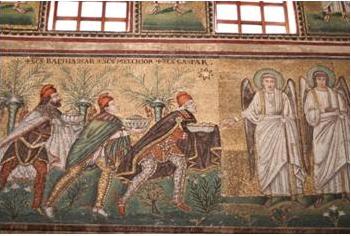
The etymology of these names is unclear. Some think that Melchor might have Akkadian origin and meaning "king"; Baltasar could derive from Persian and Akkadian Baal hashahr , "Baal is king"; the origin of Gaspar is unknown.
Then they were related to the sons of Noah: Cam to Baltasar, Shem to Gaspar and Japheth to Melchor or Melkon.
In the representation of the sarcophagus of Adelfa in Syracuse and in the Boville Ernica there are two other elements, the ox and the mule or donkey, who have obtained an absolute success in later representations of the "portal of Bethlehem." The presence of these animals refers, as indicated by the holy fathers, the prophecy of Abacud and especially that of Isaiah.
Abacud: "The Lord will be recognized between two animals"
Isaiah: "The ox knows its owner, and the ass the manger of his master, but Israel does not know me and my people do not understand me."
In any case I recognize that details of the names and the presence of the ox and the ass or mule are not issues I've studied enough or that I have extensive knowledge.
In celebration of the Day of the Kings also there converge other miscellaneous items. So at the end of the Roman Saturnalia, where gifts were made between people (see http://www.antiquitatem.com/en/christmas-birth-of-jesus- ) then were celebrated the Sigillaria, festivals in which men gave to children small ceramic figures, which were purchased at a flea market make ready for the purpose. Detail curious this markets, which are still celebrated everywhere on these dates.
Although the origin of the party may be another, linking these figurines to children is attested by Macrobius in his Saturnalia, 1, 11: "… even now (Praetextatus) intended that Sigillarias, which offer fun for children who still crawl with on clay figurines, are related to a religious practice "
vel nunc Sigillaria, quae lusum reptanti adhuc infantiae oscillis fictilibus praebent, temptat officio religionis ascribere,
Also Seneca in Letters to Lucilius, 12: 3 says:
But he said: Do not you know me? I am, Feliciu, your favorite, whom you used to give statuettes; I am the son of your butler Filostius, your little one, your joy.
" At ille "Non cognoscis me ?" inquit. " Ego sum Felicio, cui solebas sigillaria adferre. Ego sum Philositi vilici filius, deliciolum tuum."
Also in Rome, on the first day of year were held the festivities of the goddess "Strenia", whom offerings and gifts were given, which also were extended to the friends. The festival may have a Celtic origin. The name of the goddess derives form the Latin noun "strenia" gift, word which has produced the Spanish substantive “estrena” and the verb “estrenar”.
Moreover from the word "epiphany" comes the Italian "Befana", designating an old woman who on the night of 5 to 6 gives candy and chocolate to children who have been good and coal to those who have behaved wrong. The origin of this agrarian festival is related to the death of the old year and the coming of the new year.
There is another fact which helps us to better understand the astral environment in which they develop for a long time, even today, religions of all time. As I have repeatedly explained, at around day 25 December the winter solstice occurs. If until that day the sunshine or light each day have been declining, from that moment the process is reversed and the time of sun and light begins to grow. So to this day is called the "dies natalis solis invicit", "birthday of the unconquered sun".
Well, at that time it occurs in the sky the star Sirius alignment with the three stars of Orion’s belt, the Pleiades and the sun.
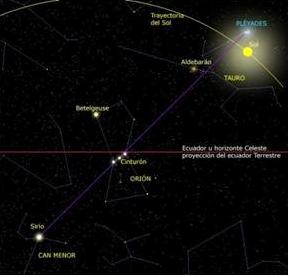
Image taken from http://asteromia.net/estrellas/estrellas-sirio.html
Someone came to consider that the three stars of Orion's belt were the three Magi who announced the birth of Christ and as such are known. But this is not an ancient identification but medieval old; I have not found a single reference in the treaties of ancient astronomy in which these three stars are denominated so. But regardless of age, that they were named so from the Middle Ages to today is proof of the ease with which humans tend to project into the firmament our beliefs and myths.
These three stars of Orion's belt are also called the Three Marys.
This whole episode of the "Three Kings" is thus a very obvious example of syncretism that occurs in the formation of myths, beliefs and rituals and force to survive for thousands of years.

